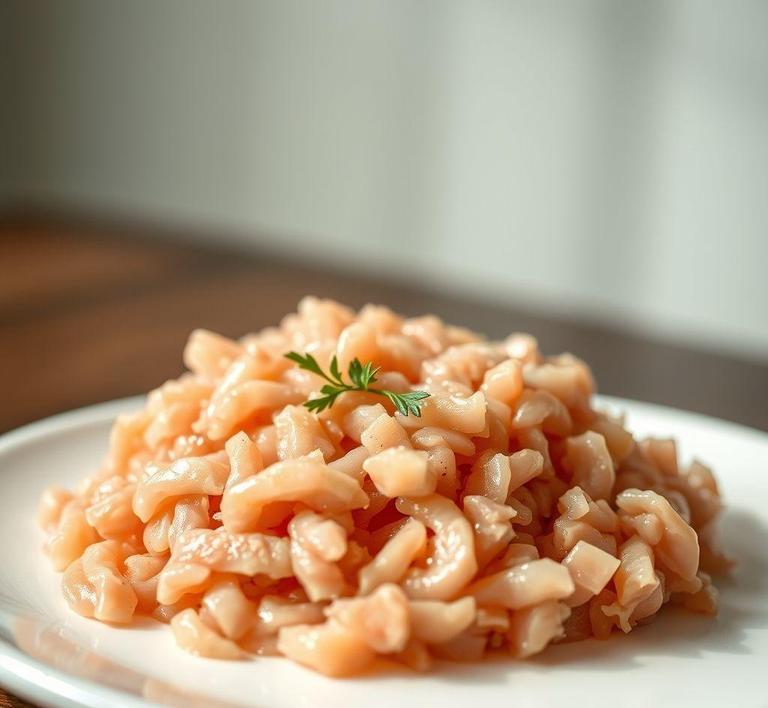Refreezing chicken mince is a topic that often raises a lot of questions in the kitchen, and it’s easy to see why! While many people know that raw chicken can be frozen for later use, they’re not always sure about the best practices when it comes to refreezing once it’s been thawed. The good news is, as long as you handle it properly, you can refreeze chicken mince safely and keep it tasting fresh for your next meal. But before you pop it back in the freezer, it’s important to understand how to do it without compromising the quality or risking food safety. In this guide, we’ll walk you through everything you need to know about refreezing chicken mince with confidence!
Can You Refreeze Chicken Mince?

Refreezing chicken mince (or ground chicken) is a common question when it comes to food safety and quality. The short answer is yes, you can refreeze chicken mince, but it requires some careful considerations. Whether you’ve thawed the mince and had second thoughts about using it, or simply want to extend its shelf life, the process of refreezing chicken mince is possible, provided certain conditions are met. However, there are factors that you should be aware of in order to ensure safety and maintain the quality of the meat.
When chicken mince is frozen, the moisture in the meat crystallizes, and when it’s thawed, some of that moisture is lost. If you refreeze it, the additional freezing and thawing process can worsen this moisture loss, impacting both texture and flavor. So, while it’s safe to refreeze chicken mince from a food safety standpoint-assuming it hasn’t been left out at room temperature for too long-understanding the implications on its quality is essential.
How To Refreeze Chicken Mince?
Refreezing chicken mince, like any other frozen food, needs to be done with caution. Here’s a step-by-step breakdown of how to do it properly:
1. Thaw It Safely First
Before you can refreeze chicken mince, it needs to be completely thawed. The safest way to do this is by placing it in the refrigerator and letting it thaw overnight or for several hours. You should avoid thawing chicken mince at room temperature because bacteria can grow rapidly at temperatures above 40°F (4°C). If you need to thaw it quickly, you can use the microwave or cold water method, but these should be done with the intent to cook the meat immediately.
2. Check For Freshness
Before refreezing chicken mince, make sure the meat is still fresh. It should smell clean, not sour or off, and have a firm texture. If it’s been in the fridge for too long (typically more than 1-2 days after thawing), it might be best to discard it instead of refreezing. Always check the expiration date if you’re working with pre-packaged chicken mince.
3. Portion It
If you don’t plan to use all of the chicken mince at once, consider portioning it into smaller, usable amounts before refreezing. This way, you can take out only the necessary amount when you’re ready to cook, minimizing the risk of multiple thawing and refreezing cycles. Use airtight freezer bags or containers to portion the mince and ensure minimal exposure to air, which helps avoid freezer burn.
4. Wrap It Properly
When refreezing chicken mince, wrapping it correctly is crucial. Use airtight packaging like heavy-duty freezer bags or vacuum-sealed bags. If using containers, ensure they’re sealed tightly. This prevents freezer burn, which happens when air reaches the food and causes dehydration, leading to flavor and texture loss.
5. Label And Date
Always label your packages with the date of refreezing. Chicken mince, even when refrozen properly, won’t last as long as fresh frozen meat. A good rule of thumb is to consume the refrozen mince within 2-3 months for the best quality. Beyond that time, it might still be safe to eat but could lose significant flavor and texture.
Quality Impact
While it’s generally safe to refreeze chicken mince, doing so can have a significant impact on the quality of the meat. Freezing and thawing affect both the texture and flavor of the chicken mince. Here’s how:
1. Texture
Chicken mince is particularly susceptible to textural changes when frozen and refrozen. This is because of the high moisture content in the meat. As the chicken freezes, the moisture within the cells forms ice crystals. When thawed, these crystals cause the cell walls to break down, releasing water. Refreezing leads to further ice crystal formation, and subsequent thawing further damages the texture. This can result in chicken mince that is more mushy or watery, rather than retaining its firm, minced quality. This is especially true if you’ve thawed and refrozen the mince more than once.
2. Flavor Loss
Freezer burn is one of the biggest risks when refreezing chicken mince. Freezer burn occurs when air reaches the food and causes dehydration and oxidation, leading to dry patches and a loss of flavor. While freezer-burned food is still safe to eat, the taste and texture will be compromised. Additionally, repeated freezing and thawing can result in the loss of some of the natural flavors, making the chicken mince taste bland or less fresh.
3. Bacterial Growth Risk
One of the biggest concerns with refreezing any meat, including chicken mince, is the potential for bacterial growth. If the chicken mince was thawed too long at an unsafe temperature (between 40°F and 140°F, or 4°C to 60°C), bacteria could start to grow. While freezing halts bacterial growth, it doesn’t kill the bacteria that may have developed during thawing. This makes it crucial to follow safe thawing and refreezing practices. If you’ve thawed chicken mince in the microwave or under running cold water, it’s important to cook it immediately to kill any potential bacteria before freezing.
4. Loss Of Nutrients
Repeated freezing and thawing of chicken mince may also result in a slight loss of nutrients. Particularly sensitive nutrients like vitamins (especially B vitamins) and proteins can degrade slightly over time with each freezing cycle. However, this loss is generally minor compared to the impact on texture and flavor.
Refreezing chicken mince is indeed possible, but it comes with some trade-offs in terms of quality. While the safety of refrozen chicken mince is assured if done properly, the texture, flavor, and nutrient content can be negatively impacted with each freezing and thawing cycle. For best results, minimize the number of times you freeze and thaw the mince. If you must refreeze, be sure to do so immediately after thawing, while ensuring that the meat was kept at safe temperatures throughout the process.
While it’s safe to refreeze chicken mince in most cases, it’s crucial to remember that the process affects the quality of the meat. If you value the texture and flavor of your meals, it’s advisable to freeze chicken mince only once. Keep your thawing and freezing practices careful, and aim to use the chicken mince within a couple of months for optimal results.
Is It Safe To Refreeze Chicken Mince?
Refreezing chicken mince can be a bit of a tricky subject, as it revolves around factors like time, temperature, and food safety practices. In theory, it is possible to refreeze chicken mince if it has been handled properly, but there are important guidelines to follow to ensure you’re not compromising the quality of the meat or putting your health at risk.
The key consideration when it comes to refreezing chicken mince lies in whether it has been thawed safely. If the chicken mince has thawed in the fridge and has not been exposed to temperatures above 4°C (40°F) for more than two hours, it’s typically safe to refreeze. The danger zone for bacteria growth lies between 4°C and 60°C (40°F – 140°F), which means if the meat has been kept out of this range for too long, refreezing it could lead to foodborne illnesses.
However, each time chicken mince is thawed and refrozen, it tends to lose moisture and may suffer in quality. The texture can become rubbery or dry, and the flavor can diminish due to the breakdown of muscle fibers. Therefore, while it’s safe under the right conditions, it’s not always the best practice in terms of preserving the integrity of the food.
Signs That Chicken Mince Should Not Be Refrozen
Before thinking about refreezing chicken mince, it’s essential to know the signs that indicate the meat should not be used again. The appearance, smell, and texture of chicken mince can all serve as indicators of whether it’s still safe to handle.
- Unpleasant Odor: If the chicken mince has a sour or off-putting smell, it’s a clear sign that it has started to spoil. Fresh chicken mince has a very mild, almost neutral odor, so any foul smells are a red flag. If you smell something rancid, it’s best to dispose of the mince, as bacteria such as Salmonella or Campylobacter could be present.
- Change in Texture: If the chicken mince feels slimy or sticky to the touch, it is an indication that it has begun to break down, potentially due to bacterial growth. The texture of chicken should remain firm and not tacky. Once this happens, even if refrozen, the quality of the meat will be compromised, and it’s not safe to consume.
- Discoloration: Fresh chicken mince is light pink or pale in color. If the meat has started turning gray, green, or has visible spots, it’s a sign of spoilage. The change in color typically indicates that bacteria have begun to proliferate, and it’s unsafe to refreeze or consume.
- Signs of Freezer Burn: Freezer burn occurs when food is improperly stored in the freezer, causing dehydration and oxidation. It appears as dry, grayish-brown patches on the meat. While freezer-burned chicken mince is still technically safe to eat, it will have a diminished flavor and texture and will not perform well if refrozen.
Common Refreezing Mistakes
Even though it’s safe to refreeze chicken mince under certain conditions, there are several common mistakes that people make when doing so. These missteps can lead to reduced quality, wasted food, and potentially unsafe consumption.
- Thawing at Room Temperature: One of the biggest mistakes people make is thawing chicken mince on the countertop at room temperature. This causes the meat to enter the danger zone where bacteria can grow rapidly. The safest way to thaw chicken mince is in the fridge, allowing it to stay at a consistent temperature. Even if you’re planning to refreeze, always thaw it safely first.
- Refreezing Without Proper Cooling: If you’ve thawed chicken mince in the fridge and decide not to use it, it’s essential to cool it down to room temperature before refreezing. Never refreeze chicken mince that’s been sitting at room temperature for more than two hours. Doing so could cause harmful bacteria to multiply and make the meat unsafe.
- Repeatedly Thawing and Refreezing: Constantly cycling between freezing and thawing can damage the texture and quality of chicken mince. The more often meat is frozen and thawed, the more moisture it loses. After a couple of cycles, chicken mince will likely become dry and tough, reducing its appeal.
- Not Using Proper Storage Methods: Refreezing chicken mince without ensuring it’s tightly wrapped or in an airtight container is a common mistake. Exposure to air can lead to freezer burn, affecting the taste and texture. It’s best to use vacuum-seal bags or tightly wrap the mince in plastic wrap followed by foil to protect it during the freezing process.
Tips And Tricks
If you’re planning to refreeze chicken mince, there are some steps you can take to minimize the risks and preserve its quality.
- Portion Control: Instead of freezing the entire batch of chicken mince at once, divide it into smaller portions. This will allow you to only thaw what you need, preventing repeated freezing and thawing of the same meat.
- Use Proper Storage Containers: Always use airtight containers or freezer bags to store chicken mince. If you’re using a freezer bag, make sure to press out as much air as possible before sealing it. For added protection, consider using a vacuum sealer to keep the meat free from air exposure.
- Label and Date: Label the chicken mince with the date you initially froze it. This way, you’ll know how long it’s been in the freezer and can avoid using it beyond its recommended time. The general rule is to consume refrozen chicken mince within 3-4 months for best quality, although it can last longer if kept at a steady, proper temperature.
- Consider Cooking Before Refreezing: If you know you won’t be able to use the chicken mince within a short time, consider cooking it before refreezing. Once cooked, you can refreeze the minced chicken, which may preserve its quality better than refreezing raw meat. Be sure to cook the mince to an internal temperature of at least 75°C (165°F) before freezing.
- Avoid Over-Thawing: If you’ve thawed chicken mince and realize you don’t need it, don’t leave it at room temperature for long periods. Thaw it quickly in the fridge or use cold water to speed up the process before refreezing. Always try to keep the meat cold as much as possible.
Conclusion
Refreezing chicken mince is possible but comes with certain caveats. While it is safe under the right conditions – provided it’s been thawed safely in the fridge and not left out at room temperature for extended periods – it’s important to be mindful of the risks to the quality of the meat. Each cycle of freezing and thawing can cause the texture and flavor to degrade, and improper handling can lead to health hazards.
By understanding the signs that chicken mince has gone bad and avoiding common refreezing mistakes, you can help ensure that your meat remains safe to eat and enjoyable. Remember to store chicken mince in small portions, use airtight packaging, and consider cooking it before refreezing to preserve the best possible quality. Ultimately, while refreezing chicken mince is sometimes necessary, it’s best to do so with caution to avoid compromising both the flavor and safety of your meal.


